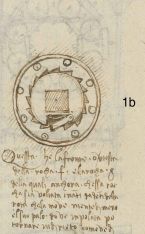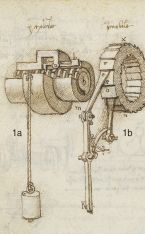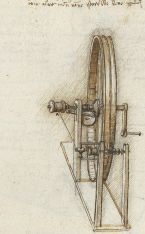Content
Fearless researcher, visionary inventor

Leonardo: Renaissance Superman
On 2 May 1519, a man of superlatives died at Clos Lucé Castle in Amboise, Leonardo da Vinci. He is not only regarded as one of the greatest painters in history, but also as an unrivalled all-round genius and universal scholar.
Leonardo, however, was more of a universal learner than a universal scholar (as the „![]() Spiegel“ magazine puts it). He received no fromal academic training and was self-taught. But his unconditional curiosity, his manifold interests, his insatiable urge for research and not least his courage were unique. He was someone who wanted to question everything, fathom everything, see through everything. And for this he accepted considerable resistance and risks. His anatomical examinations of corpses, for example, brought him into conflict with the church - and could have ended up at the stake for the freethinker.
Spiegel“ magazine puts it). He received no fromal academic training and was self-taught. But his unconditional curiosity, his manifold interests, his insatiable urge for research and not least his courage were unique. He was someone who wanted to question everything, fathom everything, see through everything. And for this he accepted considerable resistance and risks. His anatomical examinations of corpses, for example, brought him into conflict with the church - and could have ended up at the stake for the freethinker.
Inventor of everything
Let us take a brief look at Leonardo as inventor. A small example to illustrate the Leonardo´s fame as ingenious inventor also in pop culture: In a episode of the animated series "The Simpsons" Homer Simpson is active as inventor and emulates Thomas Edison. Soon he is frustrated because he believes he will never be able to achieve Edison´s multitude of inventions. Then he discovers a hint in the Edison Museum that even this great inventor has allegedly only desperately tried to catch up with another all his life: Leonardo...
Leonardo designed machine guns, self-propelled vehicles, musical instruments, paddlewheel boats, revolving stages for the theatre, flying machines and giant arm breasts, but also windmills and bridges (the Bielefeld University of Applied Sciences created ![]() models for his designs). He also worked as a cartographer (view models for his
models for his designs). He also worked as a cartographer (view models for his ![]() measuring vehicles).
measuring vehicles).
Small cracks in the cult of genius
But his qualities as an inventor are critically questioned on the occasion of the anniversary (e.g. in "![]() Die Zeit ").
Die Zeit ").
Many of Leonardo's visionary designs had decisive (thinking) errors. His helical rotor, for example, could not have flown like a helicopter because, among other things, the air density does not provide sufficient grip. The tank with eight cannons could hardly have moved with the manually operated crank drive. The famous aircrafts would probably have been enough at most for short hops. And his paddle-wheel boat would not have moved from the spot.
Not every visionary idea necessarily has to work. But some of his designs turn out to be not quite as visionary as initially assumed. The dream of flying, for example, has been on record since Homer (the Greek, not the Simpson!) at the latest (see Dädalus and Ikarus); Leonardo was also not the first to invent the parachute. Many of his military designs take up older concepts, which were known for example from the then enormously widespread work De re militari by Roberto Valturio. Leonardo has often only taken up the state of the art defined in these standard works. But with his mastery of drawing, Vinci gave his sketches an optical power of persuasion and an impression of inevitability that made them appear like mature machines that only had to be assembled.
But didn't Leonardo nevertheless give decisive impulses to later generations of engineers? The answer is no. The majority of his manuscripts and notebooks were not published during his lifetime, but disappeared after his death on partly winding paths in private collections and libraries all over the world. Most of his designs did not become known to the public until the middle of the 20th century. Leonardo thus could not have served the great inventors of the 19th and early 20th centuries as a source of inspiration.
Eye for detail
But even if he took up some suggestions of other great minds and most of his groundbreaking ideas only became known after others (mostly much later) had thought up and executed similar things - Leonardo was a great technical visionary indeed.
In an excellent project, ![]() RWTH Aachen University has published Leonardo's sketches from the so-called "Codex Madrid" in an
RWTH Aachen University has published Leonardo's sketches from the so-called "Codex Madrid" in an ![]() annotated edition. It also contains numerous
annotated edition. It also contains numerous ![]() models.
models.
The edition makes it clear: Leonardo was one of the first to devise an apparatus from its individual components. He designed parts such as levers, screws and ball bearings. He devoted himself particularly intensively to the ![]() gearing mechanism . Fascinating examples of his engineering achievements are also sketches for the spindle verge escapement of a
gearing mechanism . Fascinating examples of his engineering achievements are also sketches for the spindle verge escapement of a ![]() watch weight, the
watch weight, the ![]() gimbal mounting of a compass or a
gimbal mounting of a compass or a ![]() freewheel hub .
freewheel hub .
Many inventors still refer to Leonardo today. The fact that not everything he designed would have worked does not detract from his glory.
Pictures: Public domain / via Wikimedia Commons, Biblioteca Nacional de Espana (BNE)
Last updated: 16 April 2025




Not only protecting innovations
Social Media